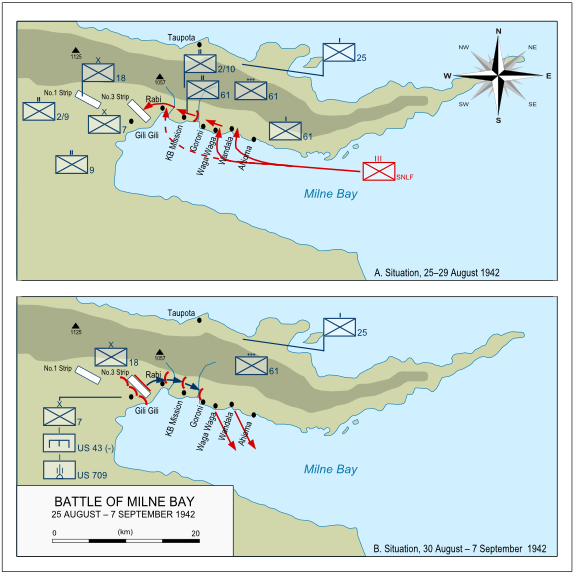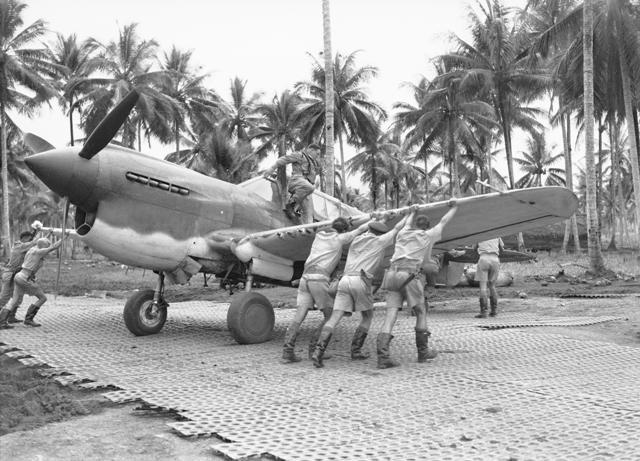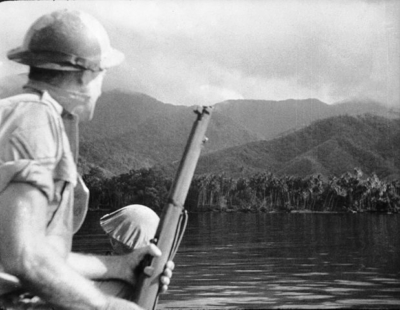MILNE BAY
Battle for Milne Bay (25 August – 7 September 1942)
On 25 June 1942 an Allied task force, escorted by Royal Australian Navy corvettes Warrego and Ballarat, landed American engineers and Royal Australian Air Force (RAAF) personnel at Milne Bay, at the extreme southeast tip of the territory of Papua.
The site had been selected for an Allied air base and three airstrips and a wireless and radar station were quickly established. By late July 1942 four RAAF squadrons were established there – Nos. 75 and 76, flying Curtiss Kittyhawk fighters and Nos. 6 and 32, operating Lockheed Hudson bombers.

The airfields and sheltered harbour of Milne Bay were eagerly sought by the Japanese and the Allies knew an attack was imminent. Two Australian Infantry Brigades were sent to protect the vital new asset: an untried Militia formation, the 7th Brigade, comprising the 9th, 25th and 61st Battalions, and the veteran 18th Brigade, containing the 2/9th, 2/10th and 2/12th Battalions, Australian Imperial Force (AIF). By mid-August, 7,459 Australians and 1,365 Americans were based at Milne Bay.

A Bofors 40mm anti-aircraft gun position manned by the 2/9th Light Anti-Aircraft Battery, Royal Australian Artillery, on the main fighter runway at Gili Gili airfield. A Kittyhawk fighter can be seen coming in to land. Included in the photograph are left to right VX36335 Jack Quick, gun layer (seated on the left), VX28384 Robert (Bob) Waterman, ammunition supplier and NX22470 B B Boughton or Buck Bearsford (?) and gun layer NX16412 Edward Preece (with binoculars on the far right).
At midnight on 26 August 1942, 2,000 Japanese marines were landed on the northern side of the bay. These landings were seriously hampered by RAAF aircraft which had attacked the invasion fleet in transit and continued to strafe and bomb the Japanese once they were ashore.
The Allied airfields lay 11 kilometres from the Japanese beachhead and the Japanese, believing them to be lightly defended, advanced towards them in spite of their heavy losses. The Japanese overwhelmed the first Australian units they encountered, the 61st, 25th and 2/10th Battalions and forced them back. The Japanese reached the edge of No. 3 Airstrip on 27 August 1942. Here they halted, awaiting reinforcements.
The Japanese charged the Airfield’s defences at dawn on 31 August 1942 but the Australian lines, manned by the 61st and 25th Battalions, held. The Japanese suffered 300 men killed and withdrew the next morning.

Milne Bay, Papua. 1942-09. Fellow pilots of 76 Squadron RAAF, lend a hand to push Squadron Leader Truscott's plane back into the dispersal bay, as he steps out of the cockpit.
The Australians now set off in pursuit of the enemy, pushing them towards their beachhead. Bitter fighting followed and losses among the outnumbered Japanese mounted. On 4 September 1942, Corporal John French (1914 – 42) performed a feat of valour at Goroni that saw him awarded a posthumous Victoria Cross. The Japanese evacuated their survivors on the night of 6 - 7 September 1942.
The fighting at Milne Bay cost Australia 377 battle casualties, including 172 dead or missing. Although relatively minor in scale, Milne Bay was a significant morale boost for Australia. Milne Bay cost the Japanese 600 of their best troops and proved for the first time that they could be decisively beaten on land. With victory at Milne Bay and later Kokoda, Port Moresby was safe.
-Neil Sharkey

013315-1
